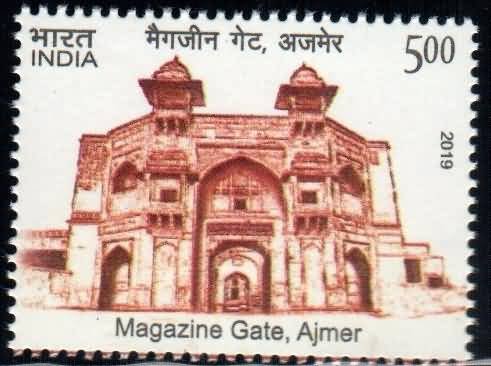Magazine Gate, Ajmer

Technical Data
| Stamp Set | Historical Gates of Indian Forts and Monuments |
|---|---|
| Date of Issue | October 19, 2019 |
| Denomination | Rs. 5 |
| Quantity | 500,000 |
| Perforation | 13¼ x 13¾ |
| Printer | Security Printing Press, Hyderabad |
| Printing Process | Wet Offset |
| Watermark | No Watermark |
| Colors | Multicolor |
| Credit (Designed By) | Sh. Brahm Prakash Sh. Pallab Bose |
| Catalog Codes |
Michel IN 3601A Stamp Number IN 3169 Yvert et Tellier IN 3279 Stanley Gibbons IN 3681 |
| Themes | Fortresses / Strongholds | Gates |
A Gateway to History and Heritage
The Magazine Gate of Ajmer stands as a splendid reminder of Mughal grandeur and colonial legacy. Serving as the main entrance to the Magazine Building, also known as Akbar’s Palace, this historic gateway carries the timeless essence of India’s architectural and cultural evolution. It was constructed under the reign of Emperor Akbar in 1570 A.D., reflecting his deep connection with Ajmer — a city he frequently visited to pay homage at the Dargah of Khwaja Moinuddin Chishti.
Architectural Brilliance of the Mughal Era
Built in striking red sandstone, the Magazine Gate is a classic example of Mughal architectural excellence. The design showcases a blend of grandeur, symmetry, and strength, characteristic of Akbar’s era. The gateway’s robust structure, with finely carved surfaces and arched openings, symbolizes the imperial authority and artistic sensibility of the Mughal period.
The gate led directly to Akbar’s Palace, a fortified structure that once served as a royal retreat during the emperor’s visits to Ajmer. The palace complex was built with thick walls and elegant courtyards, demonstrating both defensive strength and royal elegance.
From Mughal Arsenal to British Command
After the decline of Mughal rule, the Magazine Building underwent significant transformations. In 1818 A.D., it was taken over by the British from the Marathas and repurposed as an arsenal, hence earning the name “Magazine.” This transition marks an important chapter in India’s colonial history, where the same space that once hosted emperors became a symbol of military control.
The site also holds historical importance as it served as the embassy building of Sir Thomas Roe, the English ambassador to Emperor Jahangir. Roe presented his credentials to the Mughal court here on 10th January 1616 A.D., marking a milestone in Indo-British relations.
Transformation into the Rajputana Museum
In 1908 A.D., the British converted the palace and gate complex into the Rajputana Museum (now the Government Museum, Ajmer). The museum preserves invaluable relics from the Mughal and Rajput eras, including weapons, miniature paintings, sculptures, and inscriptions — offering visitors a glimpse into India’s rich cultural past.
A Living Symbol of Ajmer’s Legacy
Today, the Magazine Gate stands proudly as a protected monument, symbolizing the continuity of Ajmer’s historic and cultural significance. It narrates the story of empires, diplomacy, and transformation from the Mughal splendor of Akbar to the colonial footprint of the British Raj.
Commemorative Postage Stamp
To honor India’s architectural treasures, the Department of Posts issued a commemorative postage stamp on the Magazine Gate, Ajmer, as part of the series on Historical Gates of Indian Forts and Monuments.
The stamp celebrates this magnificent gateway as a testament to India’s layered history, architectural finesse, and enduring heritage that continues to inspire generations.
